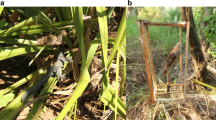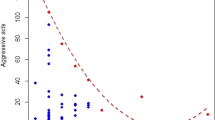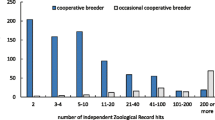Abstract
I describe siblicide in the laughing kookaburra (Dacelo novaeguineae), a reverse size-dimorphic, cooperatively breeding kingfisher. Clutches were usually of three eggs, and nestlings hatched asynchronously, with intervals of 2–72 h between successive eggs. Siblicide occurred in two temporally and mechanistically distinct episodes. The youngest nestling died in one-third of all nests within days of hatching as a result of aggression from its elders. Kookaburra nestlings attacked each other using a hook on their upper beak – a rare example of a morphological specialisation for sibling rivalry. In one-fifth of all nests, the youngest nestling starved to death much later, without overt aggression, when nestling growth rates were highest. I examined the effects of food availability and competitive disparities between nestlings on the incidence of both types of siblicide. The probability of late, starvation-mediated mortality was negatively correlated with the number of male helpers. Early, aggressively mediated siblicide occurred in nests characterised by a suite of correlated variables that I call the ”kookaburra siblicide syndrome”: (1) no male helpers attended the nest, (2) the third-hatched nestling was much smaller than the second-hatched nestling, (3) the first and second nestling to hatch were male and female, respectively, and (4) there was a short hatch interval between the first two nestlings. The kookaburra siblicide syndrome variables could be inter-correlated if they were all related to the female’s condition at the onset of incubation. Females in poorer condition may be less likely to have male helpers, more likely to lay small third eggs, and more likely to hatch the first two eggs relatively synchronously because of nutritional constraints during the onset of incubation. These females may further promote siblicide by modifying the sexes of the first two nestlings. If a female hatches soon after an older but eventually smaller brother, dominance between the first two nestlings could be destabilised. I suggest this leads to escalated aggression in the nest and the death of the third nestling, which is least able to defend itself.
Similar content being viewed by others
Author information
Authors and Affiliations
Additional information
Received: 17 December 1999 / Received in revised form: 8 May 2000 / Accepted: 20 May 2000
Rights and permissions
About this article
Cite this article
Legge, S. Siblicide in the cooperatively breeding laughing kookaburra (Dacelo novaeguineae). Behav Ecol Sociobiol 48, 293–302 (2000). https://doi.org/10.1007/s002650000229
Issue Date:
DOI: https://doi.org/10.1007/s002650000229




